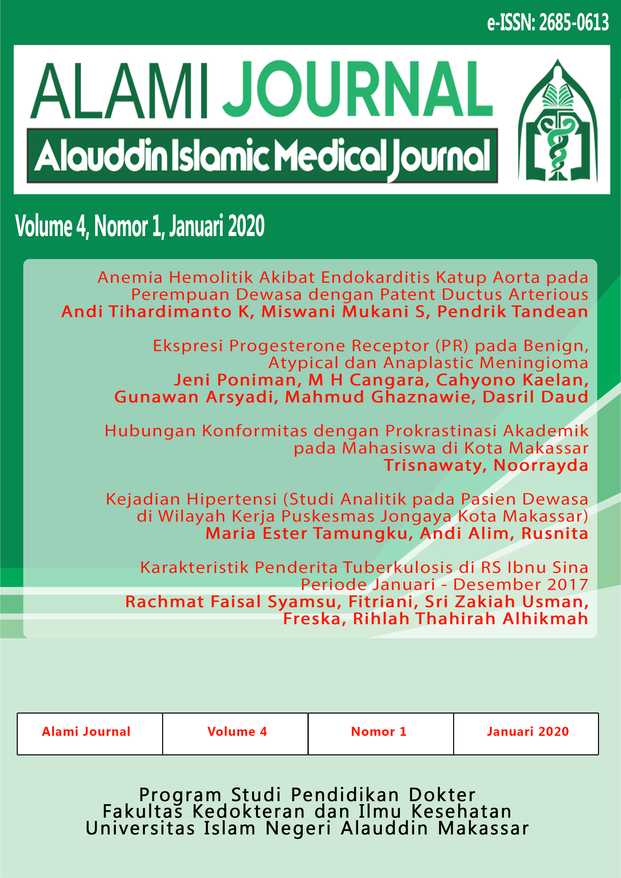EKSPRESI PROGESTERONE RECEPTOR (PR) PADA BENIGN, ATYPICAL DAN ANAPLASTIC MENINGIOMA
Abstract
ABSTRAK
Background: Meningioma is the most common brain tumour in adult which treatment and follow-up depend on the histologic grade. Aim: This research aim is to assess the difference of Progesterone Receptor (PR) expression in 3 grade groups meningioma which are benign, atypical and anaplastic meningioma. Method: It is an analytic observational research with cross sectional design using immunohistochemical staining of PR antibody on 30 samples of paraffin blocks. Result: PR immunostaining positive in benign and atypical meningioma, and PR immunostaining negative in anaplastic meningioma with p value less than 0.05 (p = 0.000). Conclusion: There is difference of PR expression in each meningioma grade groups; benign, atypical and anaplastic meningioma.
Key Words: progesterone receptor, meningioma
References
DAFTAR PUSTAKA
Perry A, Louis DN, Budka H, von Deimling A, Sahm F, Rushing EJ, et al. Meningioma. In: Louis DN, Ohgaki H, Wiestler OD, Cavenee WK, editors. WHO Classification of Tumours of the Central Nervous System. Revised4th ed. Lyon: International Agency for Research on Cancer (IARC); 2016. p. 232–7.
Perry A. Meningiomas. In: Perry A, Brat DJ, editors. Practical Surgical Neuropathology : A Diagnostic Approach. 1st ed. Philadelphia: Churchill Livingstone an affiliate of Elsevier Inc.; 2010. p. 185–217.
Scarpin KM, Graham JD, Mote PA, Clarke CL. Progesterone Action in Human Tissues : Regulation by Progesterone Receptor ( PR ) Isoform Expression , Nuclear Positioning and Coregulator Expression. Open Access J Nucl Recept Signal Atlas. 2009;7:1–13.
Wolfsberger S, Doostkam S, Boecher-Schwarz, Hans-Gerd Roessler K, van Trotsenburg M, Hainfellner JA, Knosp E. Progesterone-Receptor Index in Meningiomas : Correlation with Clinico-Pathological Parameters and Review of the Literature. Neurosurg Rev. 2004;27:238–45.
Shayanfar N, Mashayekh M, Mohammadpour M. Expression of Progestrone Receptor and Proliferative Marker Ki 67 in Various Grades of Meningioma. Acta Med Iran. 2010;48(3):142–7.
Mukherjee S, Nath Ghosh S, Chatterjee U, Chatterjee S. Detection of Progesterone Receptor and the Correlation with Ki-67 Labeling Index in Meningiomas. Neurol India. 2011;59(6):817–22.
Mukhopadhyay M, Das C, Kumari M, Sen A, Mukhopadhyay B, Mukhopadhyay B. Spectrum of Meningioma with Special Reference to Prognostic Utility of ER , PR and Ki67 Expression. J Lab Physicians. 2017;9(4):308–13.
Rosa A, Brivanlou AH. Regulatory Non-Coding RNAs in Pluripotent Stem Cells. Int J Mol Sci. 2013;14:14346–73.
Harmancı AS, Youngblood MW, Clark VE, Coskun S, Henegariu O, Duran D, et al. Integrated Genomic Analyses of De Novo Pathways underlying Atypical Meningiomas. Nat Commun [Internet]. 2017;8(14433):1–14. Available from: www.nature.com/naturecommunications
Ikeri NZ, Anunobi CC, Bankole OB. Progesterone Receptor Expression and Ki ‑ 67 Labelling Index of Meningiomas in the Lagos University Teaching Hospital. Niger Postgrad Med J [Internet]. 2018;25:17–20. Available from: www.npmj.org
Perry A. Meningioma. In: Perry A, Brat DJ, editors. Practical Surgical Neuropathology : A Diagnostic Approach. 2nd ed. Philadelphia: Elsevier; 2018. p. 259–98.
Roser F, Nakamura M, Bellinzona M, Rosahl SK, Ostertag H, Samii M. The Prognostic Value of Progesterone Receptor Status in Meningiomas. J Clin Pathol. 2004;57:1033–8.
Once an article was published in the journal, the author(s) are: granted to the journal right licensed under Creative Commons License Attribution that allows others to share the work with an acknowledgement of the work's authorship. permitted to publish their work online in third parties as it can lead wider dissemination of the work. continue to be the copyright owner and allow the journal to publish the article with the CC BY-NC-SA license receiving a DOI (Digital Object Identifier) of the work.


